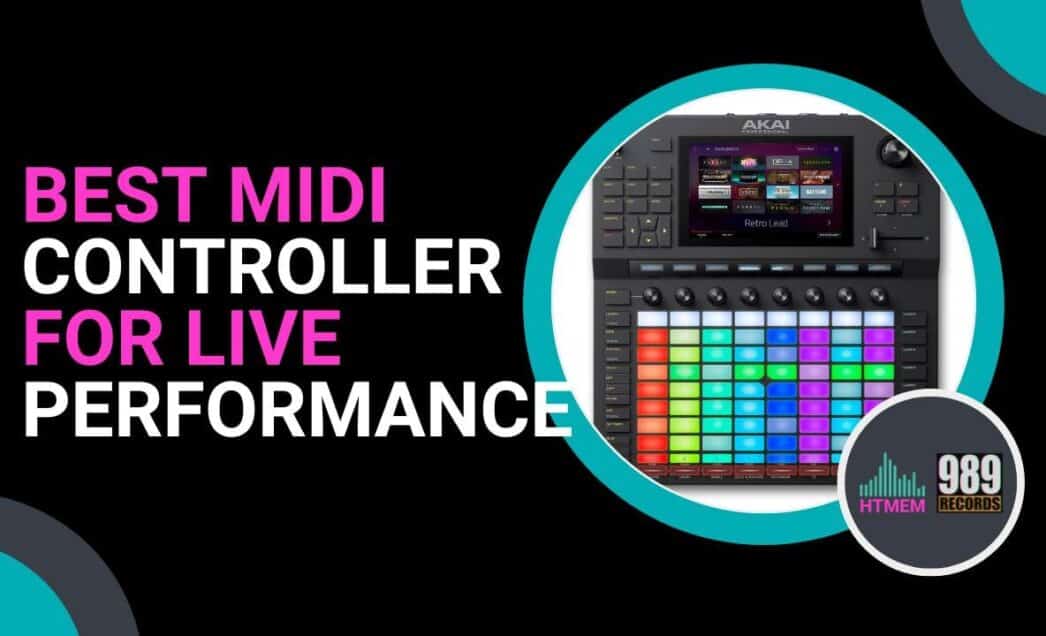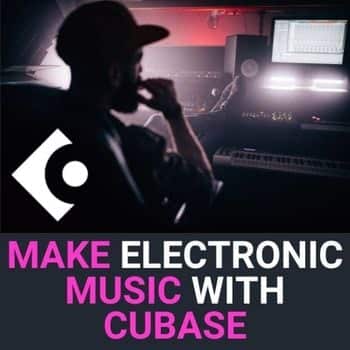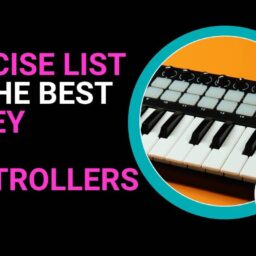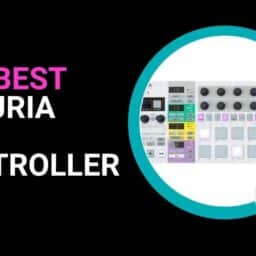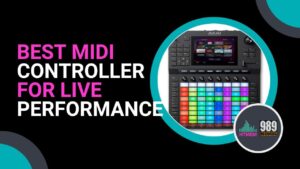
Ready to elevate your live performances?
Exploring the best MIDI controllers can be the game-changer you need for an unforgettable show. Whether you’re an experienced performer or just starting, understanding the essentials of MIDI controllers will help you make an informed decision. Many MIDI controllers come with software and VST synths for out-of-the-box use, making it easier to start creating music right away. Additionally, MIDI mapping is crucial for customizing controls to suit your specific needs during live performances.
So, let’s dive into what makes a MIDI controller the best fit for your live gigs.
Choosing the Right MIDI Controller
Selecting the perfect MIDI controller involves considering factors like portability for easy stage transitions, the number of controls for expressive play, DAW integration, and specialized features such as motorized faders and fixed chord modes. Additionally, the importance of MIDI mapping for customizing controls and enhancing live performance cannot be overstated. MIDI routing is also crucial for managing multiple MIDI devices during live performances.
These elements ensure a dynamic performance, catering to beginners and pro musicians seeking to enhance their live shows.
What to Consider When Selecting a MIDI Controller
Size and Portability: Picture this: a crowded stage, limited space, and the need for quick transitions. A compact, portable MIDI controller can be your best ally, ensuring you have everything you need right at your fingertips without the hassle of heavy equipment.
Number of Controls, Pads, and Keys: Are you into intricate beats or lush melodies? The number of controls can determine how expressively you can perform. Decide on the features you need to control your software instruments and effects seamlessly.
Specialized Features: Motorized faders, velocity-sensitive pads, touch strips—these are not just buzzwords. They’re features that can turn a standard performance into a dynamic spectacle. Seek out these enhancements for a superior live experience. Additionally, consider controllers with a fixed chord mode, which simplifies creating complex chords, making it easier for beginners or those looking to enhance their music with intricate chord progressions effortlessly. MIDI mapping is also crucial for customizing controls and enhancing live performance, allowing you to tailor the controller to your specific needs. The ‘MIDI learn’ feature is particularly beneficial as it allows for the quick assignment of controls to specific functions, streamlining your setup process and making real-time adjustments more intuitive.
Integration with DAWs (Digital Audio Workstations)
Integrating your MIDI controller with a digital audio workstation (DAW) can significantly enhance your music production workflow. Popular DAWs like Ableton Live, FL Studio, and Logic Pro X offer robust platforms for creating and performing music. MIDI controllers can be used to control virtual instruments, effects processors, and other MIDI-compatible devices within these DAWs, providing a hands-on approach to your music production.
Many MIDI controllers come with pre-mapped controls for specific DAWs, making it easier to get started. For instance, controllers designed for Ableton Live often feature dedicated clip-launch buttons and transport controls, allowing for seamless navigation and performance. On the other hand, some controllers may require manual mapping, offering more flexibility and customization options to suit your unique workflow.
When choosing a MIDI controller, consider the DAW you use most frequently and look for compatibility. Some controllers also offer wireless connectivity, using Bluetooth or Wi-Fi technology, making it easier to integrate with your DAW without the hassle of cables. This can streamline your workflow and enhance your overall music production experience.
Types of MIDI Controllers
MIDI Keyboards for Live Performance
Keyboard-style MIDI controllers are your go-to for playing software instruments and triggering loops. Opt for models with weighted or semi-weighted keys to capture every nuance of your expression. Additionally, the benefit of ‘aftertouch’ in MIDI keyboards cannot be overstated, as it adds expressiveness to live performances.
Plus, with dedicated transport controls, navigating your digital audio workstation becomes a breeze.
MIDI Pad Controllers and Control Surfaces
Need to launch samples on the fly or perform some finger drumming? Drum pads on pad controllers are perfect for just that! Choose ones with velocity-sensitive pads and customizable layouts to suit your style. For performers who need a versatile and customizable control surface, a MIDI grid controller is an excellent option. Control surfaces, on the other hand, offer a plethora of faders, knobs, and buttons for precise music production control.
Wireless MIDI Controllers
Wireless MIDI controllers are revolutionizing the way music producers and performers interact with their gear. By eliminating the need for cables, these controllers offer greater flexibility and convenience, allowing for more freedom of movement on stage or in the studio.
Wireless MIDI controllers use Bluetooth or Wi-Fi technology to connect to a computer or mobile device. Some models require a receiver to be connected to the computer, while others connect directly. This wireless capability is particularly beneficial for live performances, where cables can be a hindrance and limit your mobility.
For producers who like to work in different locations or collaborate with others, wireless MIDI controllers provide the freedom to move around without being tethered to a specific spot. When choosing a wireless MIDI controller, consider the range and reliability of the connection, as well as battery life and portability. These factors will ensure that your controller performs reliably in various settings, enhancing your live performance and music production experience.
Top MIDI Controllers for Live Performance
Let’s discover the best MIDI controllers for live performances, featuring top picks offering exceptional control, portability, and innovative features. These controllers are designed to enhance your stage presence, providing flawless integration with your music software for a superb and dynamic show.
A MIDI expression pedal can also be a valuable addition, offering dynamic control to your live performances.
Novation Launchkey Pro Mk3
Experience powerful live performances with the Novation Launchkey Pro Mk3. Its 4-track sequencer and clip-launching capabilities make it ideal for those using Ableton Live. With dedicated controls, you get seamless navigation and control over your instruments and effects. Additionally, the Novation Launchkey Pro Mk3 includes Ableton Live Lite, enhancing its value for users by allowing them to start making music immediately without needing to purchase additional software. The MIDI clock sync feature ensures precise synchronization with other MIDI devices during live performances. For those seeking an alternative, the Akai Professional APC40 MkII offers clip-launch buttons that correlate with Ableton Live’s onscreen clip colors, providing a visually intuitive experience.
Visit Vendor Site

Akai Professional Force
A standalone powerhouse, the Akai Professional Force offers a sampler, synth, and sequencer all in one. It includes pads, knobs, and a touchscreen, providing you with a comprehensive toolkit for an immersive live experience. The touchscreen helps performers avoid constantly looking at a laptop screen, maintaining their creative flow and keeping them engaged with their audience. Additionally, the MIDI routing capabilities of the Akai Professional Force allow for seamless management of multiple MIDI devices during live performances.
Visit Vendor Site
Arturia KeyLab Essential 88 Mk3
Looking for a full-size MIDI keyboard? The Arturia KeyLab Essential 88 Mk3 features 88 semi-weighted keys and function buttons that make navigating your DAW a breeze. Customize your controls and explore a range of software instruments for a show-stopping performance. Additionally, the MIDI CC (Continuous Controller) capabilities of the Arturia KeyLab Essential 88 Mk3 allow for customizing control parameters during live performances.
Visit Vendor Site
Comparative Analysis Table
Here’s a detailed comparison based on my testing and user feedback from my students:
| Feature | Launchkey Pro Mk3 | Akai Pro Force | KeyLab 88 Mk3 |
|---|---|---|---|
| Build Quality | 7/10 (Plastic) | 9/10 (Metal) | 8/10 (Semi-weighted) |
| Portability | 9/10 (4.5 lbs / 2.04 kg) | 6/10 (8.8 lbs / 4 kg) | 5/10 (28.6 lbs / 13 kg) |
| Live Performance Features | 8/10 | 9/10 | 7/10 |
| Software Integration | 9/10 (Ableton-focused) | 8/10 (Standalone+DAW) | 8/10 (Universal) |
| Price-Performance Ratio | 8/10 | 7/10 | 8/10 |
Budget Options
For emerging artists, I recommend these affordable options I’ve tested with my students:
The Arturia MiniLab MkII (~$119) is a great value for beginners. While it lacks the features of the high-end models, its build quality is better than many controllers twice its price. I used it for small club performances where space is limited.
The Novation Launchkey Mini Mk3 (~$109) is another good choice for those starting out. During my production workshops, it’s been very robust to heavy use and provides the essential features for live performance.
Setting Up Your MIDI Controller for Live Performance
Mapping Functions and Sounds
Assign your controls to trigger specific sounds and effects, or switch between different functions with ease. A MIDI foot controller, such as the Behringer FCB1010, is a useful tool for launching tracks and triggering sound parts during live performances. The ‘MIDI learn’ feature allows you to quickly assign controls to specific functions, making it easier to adapt on the fly. Leave room for some improvisation to keep your set dynamic and spontaneous.
Using an Audio Interface for High-Quality Sound
Connecting your MIDI controller to an audio interface ensures you get high-quality sound with minimal latency. Look for interfaces with multiple outputs and versatile connectivity options.
Rehearsing and Optimizing Your Live Show
Rehearsing with Your MIDI Controller: Practice makes perfect! Run through your set to fine-tune transitions and build confidence. Rehearsing with ‘MIDI clock’ synchronization is crucial to ensure tight timing during live performances.
Optimizing Your Stage Setup: Arrange your equipment for easy access and visibility. Ensuring your monitor speaker placement is spot-on can make all the difference for a balanced sound.
Rehearsing with Your MIDI Controller
Rehearsing with your MIDI controller is crucial to ensure a smooth and successful live performance. Here are some tips to help you make the most out of your rehearsal sessions:
Start by setting up your MIDI controller and audio interface in a comfortable and familiar environment. This will help you get accustomed to your gear and create a rehearsal space that mimics your live performance setup.
Practice navigating through your MIDI controller’s interface and familiarize yourself with its various features and functions. The more comfortable you are with your controller, the more fluid your performance will be.
Rehearse your finger drumming techniques and experiment with different rhythms and patterns. This will not only improve your timing and coordination but also add a dynamic element to your live show.
Practice switching between different software instruments and effects, and make sure you can access them quickly and easily during your performance. This will help you maintain the flow of your set and keep your audience engaged.
Rehearse your transitions between different songs and sections, and make sure you can execute them smoothly and seamlessly. Transitions are key to maintaining the energy of your performance, so take the time to perfect them.
Record your rehearsals and listen back to identify areas for improvement. This will give you a clear idea of what’s working and what needs adjustment, allowing you to fine-tune your performance.
Optimizing Your Stage Setup
Optimizing your stage setup is essential to ensure a successful live performance. Here are some tips to help you optimize your stage setup:
Position your MIDI controller and audio interface in a way that allows you to easily access them during your performance. This will help you stay focused and avoid unnecessary movements that can disrupt your flow.
Make sure your laptop screen is at a comfortable viewing height and distance, and consider using a laptop stand to keep it stable and secure. This will reduce strain on your neck and eyes, allowing you to concentrate on your performance.
Use a fixed chord mode to keep your MIDI controller’s chord functions consistent and predictable. This feature simplifies complex chord progressions, making it easier to play intricate harmonies on the fly.
Consider using a MIDI foot controller to add more expressiveness and control to your performance. A foot controller can free up your hands for other tasks, giving you more flexibility and creativity on stage.
Make sure your stage setup is well-organized and clutter-free, and consider using a cable management system to keep your cables tidy and organized. A clean setup not only looks professional but also minimizes the risk of technical issues during your performance.
Real-World Testing and Performance Analysis
As a Steinberg Certified Trainer with over three decades of experience, I’ve tested these MIDI controllers personally. I used these controllers in various venues and studio applications. Here’s what I found out:
The Novation Launchkey Pro Mk3 rocks in club environments where quick changes are essential. My 4-tracks Traktor DJ Software allowed me to layer complex arrangements while maintaining eye contact with the crowd – that’s key for audience engagement. However, the plastic build means you need to handle it with care during transport. The pads are very sensitive but smaller than the Akai’s, so consider that if you have larger hands.
The Akai Professional Force was a lifesaver during my live performances. Its standalone capabilities saved my set when my laptop crashed mid-performance – I just switched to the onboard sounds and went on without missing a beat. The touchscreen is responsive even in humid conditions, but hard to read in bright sunlight. The build quality is top-notch, and worth the extra cost.
Low latency is crucial for real-time music production and live performances. It ensures a more responsive and accurate playing experience, allowing musicians to perform seamlessly without noticeable delays. This is especially important when layering complex arrangements or switching between different sounds and effects in a live setting.
Latency and Performance Reliability
Latency is a critical factor in both music production and live performances. It refers to the delay between sending a MIDI signal and hearing the sound. Low latency is essential for real-time music production and live performances, as it ensures a more responsive and accurate playing experience.
Performance reliability is equally important, referring to the controller’s ability to consistently perform as expected. A reliable MIDI controller can withstand heavy use and minimize errors, providing a dependable tool for your music production needs.
When choosing a MIDI controller, look for models that offer low latency and high performance reliability. Some controllers may provide adjustable latency settings or optimization options, allowing you to fine-tune the performance to suit your specific setup. By prioritizing low latency and reliability, you can ensure a smooth and professional music production experience.
User Testimonials and Real-World Applications
The Launchkey Pro Mk3 changed my live sets,” says Sarah Chen, a techno producer I mentored who now performs at several venues across Asia. “The clip launching is amazing, but I had to make a custom case for touring.”
James Rodriguez, another of my students who is now touring with his electronic live act, shares his thoughts on the Akai Professional Force: “The standalone features are a lifesaver for reliability, but the weight is a problem for frequent flyers. I’ve learned to create backup sets on SD cards – a workflow trick Max taught me that’s saved several shows.”
Advanced Performance Tips from Real Experience
Based on my years of studio productions and teaching, here are some key takeaways I’ve learned:
- Always have at least two MIDI routes for your critical controllers – I learned this the hard way when a MIDI cable failed during a performance. Having a backup USB connection saved the show.
- Create performance templates with your most-used parameters mapped to physical controls. During my recent masterclass, I demonstrated how this reduces cognitive load during complex performances.
- For longer sets consider using multiple controllers strategically. I often use the Akai Force’s standalone features with a compact keyboard controller for maximum flexibility without overwhelming complexity.
Customizability in MIDI controllers is crucial for performers. It allows them to create a personalized setup that fits their workflow, enhancing their ability to deliver seamless and dynamic performances.
Customizability and Expandability
Customizability and expandability are key features to consider when choosing a MIDI controller. Customizability refers to the ability to tailor the controller to your individual needs and preferences, while expandability refers to the ability to add new features or functionality over time.
Many MIDI controllers offer customizable controls, such as assignable buttons or knobs, allowing you to create a personalized setup that fits your workflow. Others may offer expandability options, such as adding new modules or plugins, providing additional functionality as your needs evolve.
Customizable and expandable MIDI controllers can provide a more personalized music production experience, adapting to your changing needs and preferences. When choosing a MIDI controller, consider the level of customizability and expandability offered, and be prepared for any programming or technical expertise required to make the most of these features.
Controller Setup for Different Venues
Through my experience performing at various venues, I’ve developed these venue-specific setup strategies:
For club environments position your controller at a 15-degree angle for optimal visibility and access. This worked perfectly during my recent residency at Space Miami where the monitoring was poor.
For outdoor festivals always bring a protective overlay for your controller’s sensitive surfaces. During a recent rainy performance, this simple prep saved me from any technical issues with my Akai Force’s touchscreen.
Choosing durable and eco-friendly MIDI controllers can significantly contribute to a more sustainable music production environment. Opting for controllers made from sustainable materials not only ensures longevity but also reduces environmental impact. This approach aligns with the growing trend of sustainability in the music industry, promoting responsible consumption and production.
Sustainability and Build Quality
Sustainability and build quality are important considerations when choosing a MIDI controller. Sustainability refers to the environmental impact and longevity of the controller, while build quality refers to the construction and materials used.
A sustainable MIDI controller is designed to minimize waste and last for a long time, reducing the need for frequent replacements. Look for controllers made from durable materials and designed for longevity, as they can withstand heavy use and minimize repairs.
Some MIDI controllers may also offer eco-friendly packaging or recycling options, contributing to a more sustainable music production environment. When choosing a MIDI controller, consider the overall value and cost-effectiveness, ensuring that you invest in a high-quality, sustainable product that will serve you well for years to come.
Conclusion
Final Thoughts on Choosing the Best MIDI Controller for Live Performance
Your live performance is unique, so choose a MIDI controller that aligns with your artistic vision. Look for models with diverse controls and customizable layouts to suit your style. Remember, practice and preparation with your MIDI controller are key to delivering a memorable, flawless show.
Final Thoughts on Choosing the Best MIDI Controller for Live Performance
Choosing the best MIDI controller for live performance can be a daunting task, but by considering your specific needs and preferences, you can find the perfect controller for your music production and live performance needs. Here are some final thoughts to keep in mind:
Consider the size and portability of your MIDI controller, and choose one that is easy to transport and set up. A compact and lightweight controller can make a big difference when you’re moving between gigs.
Think about the type of music you produce and the features you need to control and choose a MIDI controller that meets those needs. Whether you need drum pads for finger drumming or dedicated transport controls for your DAW, make sure your controller has the right tools for your style.
Don’t be afraid to experiment with different MIDI controllers and find the one that feels most comfortable and intuitive to you. The best controller is one that fits seamlessly into your workflow and enhances your creative process. Testing MIDI controllers at music shops can help confirm their intuitiveness and suitability for your needs, ensuring you make the right choice for your performance style.
Consider the compatibility of your MIDI controller with your digital audio workstation and software instruments, and choose one that integrates seamlessly with your existing setup. This will ensure a smooth and efficient performance without technical hiccups.
Finally, remember that the best MIDI controller is one that inspires you to create and perform your best music, so choose one that sparks your creativity and passion. Your live performance is a reflection of your artistry, so invest in a controller that helps you shine on stage.
Suggested Readings
The Best Arturia MIDI Controller for Music Production and Performance
Practice and Enjoy!

